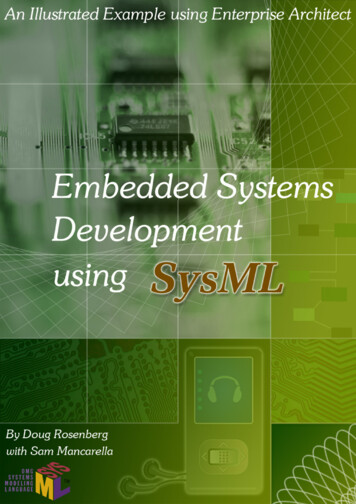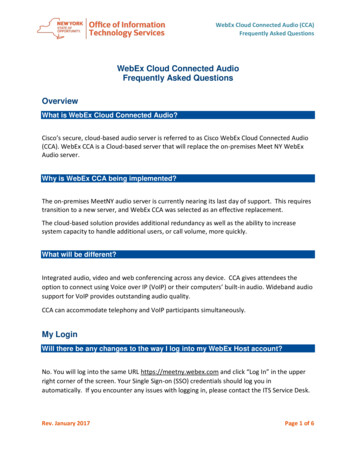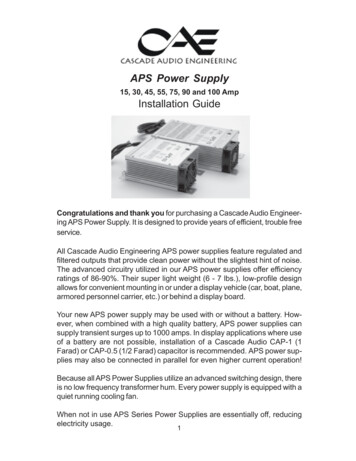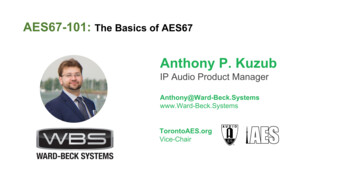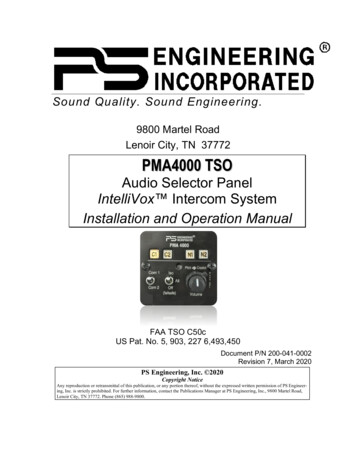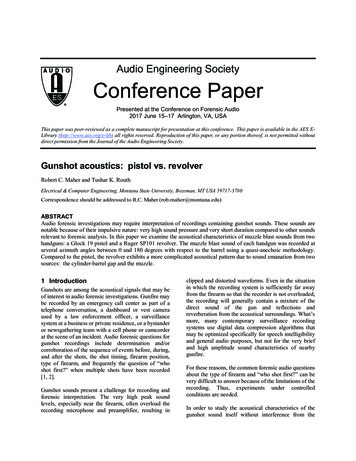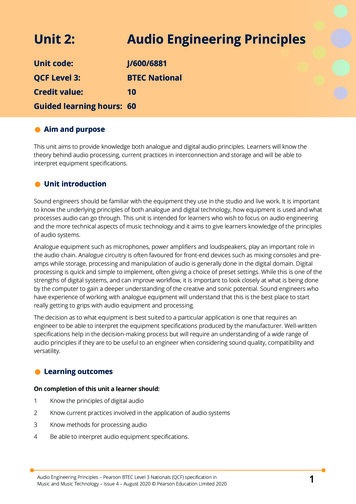
Transcription
Unit 2:Audio Engineering PrinciplesUnit code:J/600/6881QCF Level 3:BTEC NationalCredit value:10Guided learning hours: 60Aim and purposeThis unit aims to provide knowledge both analogue and digital audio principles. Learners will know thetheory behind audio processing, current practices in interconnection and storage and will be able tointerpret equipment specifications.Unit introductionSound engineers should be familiar with the equipment they use in the studio and live work. It is importantto know the underlying principles of both analogue and digital technology, how equipment is used and whatprocesses audio can go through. This unit is intended for learners who wish to focus on audio engineeringand the more technical aspects of music technology and it aims to give learners knowledge of the principlesof audio systems.Analogue equipment such as microphones, power amplifiers and loudspeakers, play an important role inthe audio chain. Analogue circuitry is often favoured for front-end devices such as mixing consoles and preamps while storage, processing and manipulation of audio is generally done in the digital domain. Digitalprocessing is quick and simple to implement, often giving a choice of preset settings. While this is one of thestrengths of digital systems, and can improve workflow, it is important to look closely at what is being doneby the computer to gain a deeper understanding of the creative and sonic potential. Sound engineers whohave experience of working with analogue equipment will understand that this is the best place to startreally getting to grips with audio equipment and processing.The decision as to what equipment is best suited to a particular application is one that requires anengineer to be able to interpret the equipment specifications produced by the manufacturer. Well-writtenspecifications help in the decision-making process but will require an understanding of a wide range ofaudio principles if they are to be useful to an engineer when considering sound quality, compatibility andversatility.Learning outcomesOn completion of this unit a learner should:1Know the principles of digital audio2Know current practices involved in the application of audio systems3Know methods for processing audio4Be able to interpret audio equipment specifications.Audio Engineering Principles – Pearson BTEC Level 3 Nationals (QCF) specification inMusic and Music Technology – Issue 4 – August 2020 Pearson Education Limited 20201
Unit content1Know the principles of digital audioDigital audio: digital theory; binary; MIDI messages; sample rate; bit depth; digital levels; decibels relativeto full scale (dBfs); dither; aliasing; oversampling; error detection and correction; digital devices egsamplers, effects processors, mixing consoles, interfaces2Know current practices involved in the application of audio systemsInterconnection: eg types of connector (XLR, Jack, RCA etc); balanced and unbalanced connections; digitalconnection types and connectors (MIDI, USB, firewire, wireless etc) operating levels (mic level, linelevel, professional and domestic levels) signal loss; maximum cable lengths; impedance; digital clock;synchronisation; networksConversion and storage: eg sample and bit rate conversion, AD/DA conversion, compression codecs,storage types and standards, server systems, transfer rates, capacity, media types, memory types3Know methods for processing audioAnalogue processing: equalisation; filters; compression; limiting; gating; expanding; delay; modulation(chorus, phasing, flanging, tremolo)Digital processing: reverberation; delay; pitch change; time-stretch; normalisation; change gain; silence;reverse; fade in/out; physical modelling (amp simulation, effects)4Be able to interpret audio equipment specificationsEquipment specifications: eg frequency range, frequency response, power bandwidth, sensitivity,signal-to-noise ratio, operating level, power rating/handling, RMS, peak, continuous, program,impedance; analogue devices eg microphones, pre-amps, crossovers, power supplies, amplifiers, filters,loudspeakers; analogue audio theory; Ohm’s law; voltage; current; resistance, power; decibels (dBu,dBV, dBSPL etc)2Audio Engineering Principles – Pearson BTEC Level 3 Nationals (QCF) specification inMusic and Music Technology – Issue 4 – August 2020 Pearson Education Limited 2020
Assessment and grading criteriaIn order to pass this unit, the evidence that the learner presents for assessment needs to demonstrate thatthey can meet all the learning outcomes for the unit. The assessment criteria for a pass grade describe thelevel of achievement required to pass this unit.Assessment and grading criteriaTo achieve a pass grade theevidence must show that thelearner is able to:To achieve a merit grade theevidence must show that, inaddition to the pass criteria,the learner is able to:To achieve a distinction gradethe evidence must show that,in addition to the pass andmerit criteria, the learner isable to:P1define the principles ofdigital audio[RL, SM]M1explain the principles ofdigital audioD1assess the principlesof digital audio relatingto specific digital audioequipmentP2outline current practicesinvolved in the applicationof audio systems[IE, SM]M2explain current practicesinvolved in the applicationof audio systemsD2assess current practicesinvolved in the applicationof audio systemsP3illustrate methods forprocessing audio[IE, SM]M3explain methods forprocessing audioD3assess methods forprocessing audioP4recommend equipmentM4through the interpretationof audio equipmentspecifications with a degreeof independence.[RL, SM]explain equipmentrecommendations throughthe interpretation of audioequipment specificationswith no tutor input.D4justify equipmentrecommendations throughthe interpretation of audioequipment specificationsby explaining the audioprinciples behind them.PLTS: This summary references where applicable, in the square brackets, the elements of the personal,learning and thinking skills applicable in the pass criteria. It identifies opportunities for learners todemonstrate effective application of the referenced elements of the skills.KeyIE – independent enquirersRL – reflective learnersSM – self-managersCT – creative thinkersTW – team workersEP – effective participatorsAudio Engineering Principles – Pearson BTEC Level 3 Nationals (QCF) specification inMusic and Music Technology – Issue 4 – August 2020 Pearson Education Limited 20203
Essential guidance for tutorsDeliveryThe technical aspects of this unit form the foundation for a wide range of areas of study including soundrecording, live sound engineering, acoustics, synthesis and sampling. All of the concepts and principlesinvolved lead learners to investigate the equipment and technology available to engineers, producers andrecording musicians.This unit and Unit 1: Acoustics for Musicians give learners confidence in their understanding and control overthe technology. Tutors might wish to integrate aspects of this unit with some of the other more practicalunits and those units that have a system specification design element.While some of this unit may need to be delivered using a lecture-style approach it is essential that thetheory be established through practical experience of the equipment it relates to. For example, wheninvestigating digital theory learners could be introduced to a hardware sampler or digital recording device.Music software can be used to visually show audio processes and effects. For example, when comparingthe waveform of a sound before processing and again after processing it learners will become used toseeing the processes happen and will then be able to relate to what is happening sonically. For example,a tremolo effect will show a visible rise and fall in amplitude and an EQ can be seen working, especiallywhen combined with the use of a real-time audio analyser. An oscilloscope can be used to show waveformsand, together with audio testing equipment, can be used to test the frequency response of audiorecording equipment. Access to equipment manuals and technical specifications is essential as is accessto online resources such as manufacturer websites where technical details, diagrams and pictures can bedownloaded.It is preferable to vary the delivery approach to avoid overloading learners with technical concepts.The grading criteria are concerned with the main principles involved in analogue and digital audio, notnecessarily the physics, mathematics and electronics behind those principles.When setting a more practical assignment to assess learning tutors should be careful that the tasksgenerate the correct evidence to meet the grading criteria. In most cases sets of questions could begenerated to help learners focus on the theory behind what they are doing. It would be good practiceto have regular question and answer sessions or quizzes to help keep learners focused and monitor thelearning process prior to the main assignments. It may be suitable in some cases to set questions as partof ‘time constrained assessments’ alongside the practical and more contextualised assessments. Tutorsshould not, however, rely solely on tests to produce the evidence for this unit.4Audio Engineering Principles – Pearson BTEC Level 3 Nationals (QCF) specification inMusic and Music Technology – Issue 4 – August 2020 Pearson Education Limited 2020
Outline learning planThe outline learning plan has been included in this unit as guidance and can be used in conjunction withthe programme of suggested assignments.The outline learning plan demonstrates one way in planning the delivery and assessment of this unit.Topic and suggested assignments/activities and/assessmentIntroduction to unit and assessment.Tutor-input sessions covering audio principles – introductory overview, audio theory, sound, analogue/digitalsignals, frequency, sound levels, Ohm’s law, S/N ratio.Tutor-input sessions covering digital audio principles – binary, sample rate, bit depth. Digital studioequipment.Assignment 1: Digital Audio Glossary – P1, M1, D1zPractical use/testing of equipment.zPortfolio development.Tutor-input sessions covering interconnection – cables, connectors, and signal types. Conversion – AD/DA, sample rate, bit depth. Storage – media types, file sizes, transfer, compatibility. Current practices –discussion, practicalities and moving between studios.Assignment 2: Studio Plan – P2, M2, D2zInvestigation/use of studio equipment.zPortfolio development.Tutor-input sessions covering audio processing – typical equipment found in a studio rack (EQ,compression, gates, effects) – diagrams, visual explanation. Digital processing – typical functions of audioediting software (normalise, time-stretch, fade, silence). Digital ‘models’ of audio effects – comparison, visualrepresentation of effects, seeing the sound on screen, amp simulation.Assignment 3: Effects and Processing – P3, M3, D3zInvestigation/use of studio equipment.zPortfolio development.Audio principles – revision.Technical specifications – relate to audio principles, equipment specification sheets – recommendations,explanation and justifications.Assignment 4: Equipment Specifications – P4, M4, D4zTime-constrained assessments.Audio Engineering Principles – Pearson BTEC Level 3 Nationals (QCF) specification inMusic and Music Technology – Issue 4 – August 2020 Pearson Education Limited 20205
AssessmentWhere assessment is based on a practical activity and/or presentation, assessors should ensure thatappropriate evidence is provided, for example video recordings.Learning outcome 1 requires that learners know the principles of digital audio. They should be encouragedto relate this theory to specific examples of equipment such as samplers and recording devices.Learning outcome 2 requires that the learners have a working knowledge of current practices but also theissues relating to storage, connection and conversion. The connections within a small recording studiowould make a good case study and the basis for an assessment.Learning outcome 3 requires that learners know about a range of audio processes. In most cases audioprocesses are best explained using well-labelled and annotated diagrams. In this way learners will see whatis happening to the audio and will be able to relate it to what they hear while working in the studio or at aDAW.Learning outcome 4 requires that learners are able to interpret technical specifications. Tutors will need tosupply examples of audio specifications that necessitate the coverage of a broad range of audio principlesand suitable questions that ask for explanation and technical reasoning. It is the use and understanding ofaudio principles in these specifications that is important, so it should not be seen as an exercise in findingexamples of poorly written specifications.To achieve P1, learners need to define the principles of digital audio as set out in the unit content. Thisshould be technically correct but can be brief. For example, a simple glossary of terms could be producedto meet this criterion.For M1, learners should explain some of the aspects identified within the unit content including sample rateand bit depth. Diagrams could be used to help explain topics.For D1, learners will assess the principles of digital audio relating to specific equipment. This is likelyto follow on from and use detailed examples to expand on the explanation and include discussion offrequency response relating to sample rate and signal to noise ratio relating to bit depth.To achieve P2, learners must outline current practices in sound equipment interconnection, how sound/data is stored and what is involved in the conversion of sound/data. Evidence is likely to be brief and factual.For M2, evidence should include explanation of specific examples as outlined in the unit content. Diagramscould be used to help explain topics.For D2, learners will assess current practices in the application of audio systems such as audio quality, useof high sampling rates, compatibility between systems, digital transfer, signal loss when using long cablelengths, improving workflow in the studio and future developments.To achieve P3, learners must produce illustrations that represent the range of effects and audio processes.Diagrams should be technically accurate and be a good representation of the process being illustrated.For M3, learners will explain how the effects or processes work.For D3, learners will assess the effects and processes. This could involve looking at specific effects within asoftware package and assessing their features, degree of control and sound quality. Comparisons shouldbe made, for example between similar effect types and/or analogue and digital units/processors.To achieve P4, learners will make recommendations for audio equipment based on interpretation ofspecifications. It is expected that a microphone, a power amplifier and loudspeaker be included to allowcoverage of important principles relating to common specifications such as frequency, decibels, power andimpedance. Evidence is likely to be brief but should explain what each specification means.6Audio Engineering Principles – Pearson BTEC Level 3 Nationals (QCF) specification inMusic and Music Technology – Issue 4 – August 2020 Pearson Education Limited 2020
For M4, learners will need to show they can explain the audio principles behind the specifications, coveringa range of audio specifications as outlined in the unit content.For D4, learners will need to show they can justify their recommendations using their knowledge of theaudio principles behind the specifications, using effective and logical reasoning for items selected.Programme of suggested assignmentsThe following table shows a programme of suggested assignments that cover the pass, merit anddistinction criteria in the grading grid. This is for guidance and it is recommended that centres either writetheir own assignments or adapt any Pearson assignments to meet local needs and resources.Criteria coveredAssignment titleScenarioP1, M1, D1Digital AudioGlossaryYou have been asked to writea glossary of digital audioprinciples and assess thequality of digital equipment.P2, M2, D2P3, M3, D3P4, M4, D4Studio PlanEffects andProcessingEquipmentSpecificationsYou are designing a smallmusic studio. Producediagrams and explanation toshow the interconnections,conversion and storage.Produce diagrams thatillustrate and explain arange of audio effects andprocessing.You are given a range ofaudio equipment and askedto make recommendationsbased on the technicalspecifications.Audio Engineering Principles – Pearson BTEC Level 3 Nationals (QCF) specification inMusic and Music Technology – Issue 4 – August 2020 Pearson Education Limited 2020Assessment methodzWritten report.zWeb page.zPresentation.zBooklet.zWeb page.zPresentation.zBooklet.zWeb page.zPresentation.zTime-constrainedassessment.7
Links to other BTEC unitsThis unit forms part of the BTEC Music and Music Technology sector suite. This unit has particular links withthe following unit titles in the BTEC Music and Music Technology suite:Level 1Level 2Level 3Acoustics for MusiciansLive Sound TechniquesEssential resourcesThis unit can be delivered entirely through classroom or lecture activity but a great deal of the requiredlearning can, and should, take place in a practical environment where possible. Access to a suitable rangeof audio equipment such as compressors, effects units and EQ, as well as music software will be essentialin the development of knowledge and in putting the theory into context. Music software can show visuallywhat analogue equipment may not (eg EQ) while real hardware allows a hands-on approach. Access tosignal generators, oscilloscopes and audio test equipment would be an advantage as this would allowlearners to see test results for specifications such as frequency response, SPL readings and distortion.Equipment specifications and manuals will be necessary for comparative purposes.Employer engagement and vocational contextsTechnical roles within the industry offer a wide scope for employment. This unit gives the learner theunderpinning knowledge that will help them move into areas such as live sound, analogue electronics, DSP,product design and manufacture.Delivery of personal, learning and thinking skills (PLTS)The table below identifies the opportunities for personal, learning and thinking skills (PLTS) that have beenincluded within the pass assessment criteria of this unit.SkillWhen learners are Independent enquirersresearching information sources online and in textbooksReflective learnersusing technical information to assess audio equipmentSelf-managersmanaging own time to meet assessment deadlines.Although PLTS opportunities are identified within this unit as an inherent part of the assessment criteria,there are further opportunities to develop a range of PLTS through various approaches to teaching andlearning.SkillWhen learners are Creative thinkersexploring audio effects for creative possibilitiesTeam workersworking with musicians in creative recording situationsEffective participatorsbringing audio solutions to creative situations.8Audio Engineering Principles – Pearson BTEC Level 3 Nationals (QCF) specification inMusic and Music Technology – Issue 4 – August 2020 Pearson Education Limited 2020
Functional Skills – Level 2SkillWhen learners are EnglishSpeaking and listening – make a range ofcontributions to discussions and makeeffective presentations in a wide range ofcontextspresenting technical information to the learner groupReading – compare, select, read andunderstand texts and use them to gatherinformation, ideas, arguments andopinionsreading technical information and selecting information that isrelevant to the topic areaWriting – write documents, includingextended writing pieces, communicatinginformation, ideas and opinions, effectivelyand persuasivelywriting explanations of the topic area and presenting a widerange of technical information in an understandable format.RR050820 Unit 2 Audio Engineering Principles issue 4Audio Engineering Principles – Pearson BTEC Level 3 Nationals (QCF) specification inMusic and Music Technology – Issue 4 – August 2020 Pearson Education Limited 20209
Unit 2: Audio Engineering Principles Unit code: J/600/6881 QCF Level 3: BTEC National Credit value: 10 Guided learning hours: 60 Aim and purpose This unit aims to provide knowledge both analogue and digital audio principles. Learners will know the theory behind audio processing, current practices in interconnection and storage and will be able to

